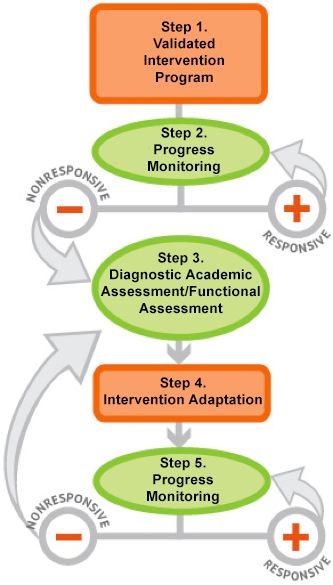What is data-based individualization?
Page 1: Overview of Data-Based Individualization

Like Natalia, the student depicted in this module’s Challenge, approximately 5–10% of all students do not respond adequately to targeted instruction (i.e., Tier 2 instruction, secondary level instruction). Students who have severe and persistent academic difficulties need more intensive intervention, often referred to as Tier 3 or tertiary level instruction. In contrast to targeted instruction, intensive intervention is characterized by:
- Increased intensity (e.g., more instructional time, smaller group size)
- Individualization of instruction
Data-based individualization, or DBI, offers a systematic approach for providing intensive intervention. DBI is a research-based process for gradually intensifying and individualizing interventions through the systematic use of assessment data, validated interventions, and research-based adaptation strategies. More specifically, DBI:
- Uses data to help determine how and when students need additional support or intervention
- Is typically content-specific; a student may receive DBI in one content area (e.g., reading, math) or one content-area skill (e.g., comprehension, multiplication) and not others
- Is an ongoing process of making and evaluating instructional adaptations
For Your Information
If a school is not implementing a multi-tiered approach, can teachers still use DBI to provide intensive intervention? Yes, many components of DBI are consistent with multi-tiered system of supports (MTSS), such as response to intervention (RTI) and positive behavioral intervention and supports (PBIS). They all use progress monitoring, individualization, and data-based decision making as part of their process. DBI should be implemented at the most intensive and individualized level of support within these systems (i.e., Tier 3 or tertiary level instruction, special education).
multi-tiered system of supports (MTSS)
A model or approach to instruction that provides increasingly intensive and individualized levels of support for academics (e.g., response to intervention or RTI) and for behavior (e.g., Positive Behavioral Interventions and Supports or PBIS).
response to intervention (RTI)
A multi-tiered approach for delivering instruction to learners through increasingly intensive and individualized interventions.
Positive Behavioral Intervention and Supports (PBIS)
A three-tiered framework (i.e., primary, secondary, tertiary) that provides a continuum of supports and services designed to promote appropriate behaviors and to prevent and address challenging behaviors.
When a school utilizes an MTSS, DBI begins when a student is not responding adequately to a targeted evidence-based intervention that is being implemented with fidelity (i.e., as intended by the researchers). DBI consists of the five steps outlined in the table below and depicted in the graphic. Notice that the graphic indicates how to proceed when a student is responsive or nonresponsive to the intervention.
evidence-based intervention
A practice or program that has been proven to be effective for the majority of students through experimental research studies or large-scale research field studies.
| DBI Steps |
|---|
| Step 1. Validated Intervention Program: Make the secondary intervention more intensive through quantitative changes to the instruction that a student receives. |
| Step 2. Progress Monitoring: Evaluate the student’s response to the intensified intervention by collecting progress monitoring data.
x
progress monitoring A type of formative assessment in which student learning is evaluated on a regular basis in order to provide useful feedback about performance to both learners and instructors. The resulting data can be graphed to observe change over time. Sometimes referred to as curriculum-based measurement (CBM) or general outcome measurement (GOM). |
| Step 3. Diagnostic Assessment: Collect and review data (e.g., progress monitoring data, student work samples, observations) to identify areas of difficulty and to make informed decisions about how to adapt the intervention. |
| Step 4. Intervention Adaptation: Adapt the intervention based on the student’s needs as determined by the diagnostic assessment. |
| Step 5. Progress Monitoring: Continue to collect progress monitoring data to evaluate the student’s response to the instructional adaptations. |

This graphic illustrates both the steps of data-based individualization, as well as they ways in which those steps interact. Step 1, “Validated Intervention Program,” is represented by an orange rectangle. This box connects via a vertical grey line to Step 2, “Progress Monitoring,” which is illustrated as a green oval. Both steps, in turn, are connected to a horizontal line with labeled circles at each of its ends. The circle on the left, “Nonresponsive,” has a red minus sign at its center, while the circle on the right, “Responsive,” has a red plus sign. A grey arrow connected to the “Nonresponsive” circle points toward Step 3 of the DBI process, “Diagnostic Academic Assessment/Functional Assessment,” which is represented as a green oval, similar to Step 2. The “Responsive” circle also has a grey arrow, this one pointing back up toward Step 2, “Progress Monitoring.”
Step 3 is connected via a vertical grey arrow to Step 4, “Intervention Adaptation,” represented as an orange rectangle. Another grey arrow connects Step 4 to Step 5, “Progress Monitoring,” another green oval. As above, these latter steps are connected to a horizontal line with labeled circles at each of its ends. The circle on the left, “Nonresponsive,” has a red minus sign at its center, while the circle on the right, “Responsive,” has a red plus sign. A large grey arrow connected to the “Nonresponsive” circle points back to Step 3, “Diagnostic Academic Assessment/Functional Assessment,” while the “Responsive” circle directs instructors back to Step 5, “Progress Monitoring.”
If students with severe and persistent learning difficulties are to make adequate progress, teachers might need to implement Steps 3, 4, and 5 of the DBI process multiple times to reach the required levels of intensity and individualization. In this way, DBI is an iterative process: That is, the school team intensifies a practice or program through the cyclical process of diagnostic assessment, intervention adaptation, and progress monitoring.
This module, part 2 in a series, focuses on the data-related steps of DBI (i.e., Step 2: progress monitoring, Step 3: diagnostic assessment, and Step 5: progress monitoring), all of which are covered in more detail on the following pages. If you have not already done so, we strongly suggest that you view the first module in this series that discusses the intervention aspects of DBI (i.e., Step 1 and Step 4):
For Your Information
![]() For more information on DBI, visit the National Center on Intensive Intervention website.
For more information on DBI, visit the National Center on Intensive Intervention website.